A Brown degree is a great equalizer.
You get the same initials—AB, say, or AM or PhD—no matter how you've earned them. Every Commencement program has pages covered with the names of newly minted graduates, lists of people all receiving the same degree.
The columns go on and on with alphabetical determinacy, starting at A and marching all the way to Z. The list imposes a kind of anonymity of achievement; the name of a student who just barely made it might be just below one of the most brilliant students Brown has ever seen.
So it is with many traditions, whose purpose, after all, is to subsume the individual to the great flood of history. A Commencement program truly representing the graduating class would be 1,500 pages long, each one telling the story of a single graduating senior. The result would be an epic anthology of rewards and disappointments, of deepening friendships andunexpected betrayals, of new discoveries and failed experiments, of broken hearts and spontaneous love. Can you imagine what an everlasting keepsake such a program would be? n We can't possibly tell all these stories. Instead we offer six—five undergraduates and one graduate student. These stories can't adequately convey the range of journeys traveled by the members of the class of 2010, but they'll give you sense of how extraordinary they all must be.
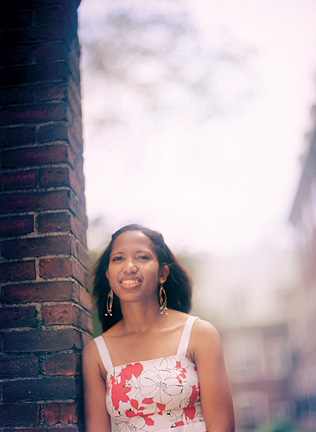
There was never any question about where Eliana Castro '09 would want to work after she got her master's in teaching: back in her hometown of Lawrence, Massachusetts.
Castro was six when she left her family's farm in the Dominican Republic to join her mother, who was working as a nurse in Lawrence, an old industrial city with brick factories and warehouses left over from its heyday as a center of textile manufacturing. Eliana didn't speak any English, and her transition from rural village to mill city was a difficult one. "I was used to playing outside," she says, "even in the mud and rain. I felt like I was being deprived of what I cherished."
Her sanctuary was school. After learning English in kindergarten, Castro was switched out of the bilingual program at the end of first grade and into the school's main learning track. Her third-grade teacher took Castro under her wing, becoming an early mentor.
"We had a really special connection," Castro says. "All my teachers knew that I was a good student, but she was really invested in making sure I knew that." The connection between teacher and student continued long after Castro moved beyond third grade: when Castro graduated from Brown last year, her old teacher watched from a seat on the College Green.
Castro attended Brown thanks to the Sidney E. Frank '42 Endowed Scholarship Fund, which provides financial assistance to Brown's neediest undergraduates. She also worked as a student fund-raiser, cold-calling alumni to ask for donations. Working only seven hours a week in her junior and senior years, she raised more than $300,000—twice as much as any student before her. "It was a great way to make sure the money was coming back in," she says. "It was a way of giving back."
Now Castro is dedicating herself to giving her students in Lawrence the kind of support she got from her third-grade teacher. "As I grew up," she says, "I had a lot of support from teachers, and built really strong relationships with the adults in my school. I've always aspired to do the same for other young people."
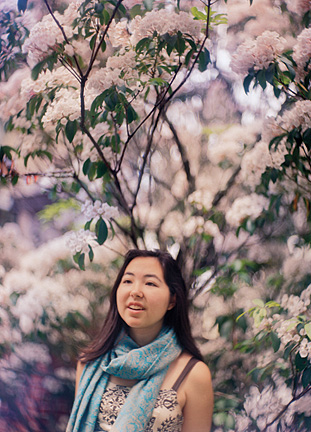
Masumi Hayashi-Smith grew up in Tacoma, Washington, the daughter of a Japanese American mother and a Caucasian father. Her mother had grown up Buddhist, her father, atheist. As adults, her father turned to Buddhism, and her mother became an atheist. Hayashi-Smith followed her father's lead: Buddhism "just feels natural to me," she says. "It's the way I'm oriented toward the world."
In the summer of 2009, using funds she was awarded through the Solsbery Endowed Fellowship, Hayashi-Smith traveled to Sri Lanka to work with a Buddhist group called the Sarvodaya Shramadana Movement (Sanskrit for "awakening of all"). One of the organization's objectives is to improve relations between the majority Sinhalese ethnic group in Sri Lanka and the Tamil minority. Only a few weeks before Hayashi-Smith arrived in the country, the twenty-six-year civil war between the two groups had ended, after the government defeated a Tamil resistance group.
Hayashi-Smith traveled around Sri Lanka with Sarvodaya Shramadana's Shanthi Sena or "Peace Brigades," which focus on the nation's youth. The program ran camps in rural areas, where roughly 200 Sinhalese, Muslim, and Tamil kids spent three days together. During that time, the teens stayed in local villagers' homes, sharing a bedroom with a member of a culture they knew little about and might even have considered an enemy. During the day counselors staged team-building exercises, and the camp held ecumenical services, during which campers recited or rallied around such Buddhist mantras as "We are all one," and "There's no defined self."
At the end of the program, Hayashi-Smith was amazed. "People kept giving these speeches that there were no differences between them, they were all one, they were all Sri Lankan," she says. "These people got really, really close to each other. They would shed tears when they had to part."
Hayashi-Smith wrote a research paper on what she'd observed in Sri Lanka, concluding that the program was highly effective. But she also had concerns that the camps' emphasis on unity and a shared nationality shunted aside the very real grievances and needs of the Tamils.
Next year Hayashi-Smith will return to Sri Lanka on a Fulbright scholarship to work again with Sarvodaya Shramadana and other youth peace programs in the region. Whatever qualms she has about the program, she still considers it an exemplary model of putting Buddhist principles into practice to improve the world.
"Because of these camps," she says, "these kids all realized they have this common humanity and the capacity to love one another."
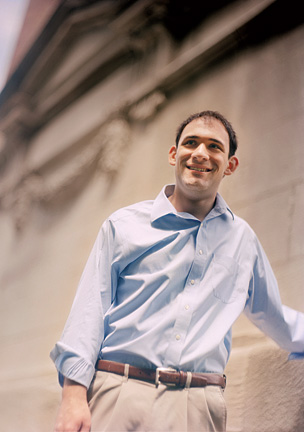
When Jeremy Goodman looks back on his time at Brown, he may well be able to say it all came together for him in the shower. "I do a lot of my best original thinking in the shower in the mornings," he says. "I found I was always thinking about philosophy." And so Goodman, who earned a prestigious Marshall Scholarship to study at Oxford next year, plans to become a philosopher.
It didn't start out that way. When Goodman arrived at Brown, he thought he would focus primarily on physics. But his goal, he says, was to try and make an original contribution to the field he was studying, and "physics isn't the kind of research area where an undergraduate can make a lot of progress."
He believed neuroscience was, however. While in high school in Bethesda, Maryland, Goodman had worked at a University of Maryland research lab studying the connection between brain activity and hearing. In the summer of his freshman year at Brown, he landed an internship at the National Institutes of Health, again at a lab focused on neuroscience.
Goodman returned to the NIH lab over the next two summers, working with a brain-imaging technique known as magnetoencephalography (MEG), which produces a map of the brain by charting the magnetic fields produced by the electrical firings of its neurons. As part of his undergraduate research, Goodman enrolled forty subjects and used MEG to observe their brains while he asked them questions.
"A large gray animal is an elephant; you press one button. A large gray animal is a toaster; you press another," Goodman explains. "It's activating some sentence-level semantic processing." MEG gives you a millisecond-by-millisecond breakdown of the route the electric current travels across the brain as it carries out that processing.
About half of people involved in Goodman's experiment were epileptics, and Goodman believes that the promise of his research is that doctors, who sometimes treat epilepsy with brain surgery, will be more confident that they are not removing any brain tissue that might interfere with vital cognitive processes. He says that MEG could give surgeons a clearer idea of where these processes take place in the brain of a patient before he or she goes into surgery.
Goodman plans to spend this summer writing a research paper about his findings to submit to a scientific journal. If the paper is accepted for publication, he will be listed as the first author, no small feat for someone who's just earned a bachelor's degree.
In the long term, though, Goodman says he would still rather study philosophy than neuroscience. It all goes back to those showers. Answering the questions he poses to himself while soaping up appears to be his destiny.

When you learn that Emily Taylor has earned a prestigious Woodrow Wilson-Rockefeller Brothers Fund Fellowship for Aspiring Teachers of Color—an award from the Woodrow Wilson Foundation in Princeton, New Jersey—you assume that she has always been a masterful teacher. Yet, referring to her experience teaching middle school in San Jose, California, during the summer of her freshman year, Taylor says: "It was one of the hardest things I've ever done."
That's when her talent and drive kicked in. Faced with the task of preparing daily lesson plans and managing a classroom of kids who often did not want to be stuck in a school over the summer, she dreamed up innovative approaches to teaching literacy skills. She had her students make ice cream sundaes as a way of learning how to construct a paragraph. She asked them to stage a debate on whether the United States should be more like a melting pot or a salad bowl. "I was so invested in it," she says. "I just loved the time I spent with the kids."
In her junior year, as part of Brown's Urban Education Semester program and later as the recipient of a Royce Fellowship from the Swearer Center for Public Service, Taylor spent time teaching and studying conflict resolution at a New York City elementary school. Every week, the school gathered its fourth graders for a community meeting at which students and teachers aired grievances and resolved conflicts.
"I was really blown away by the difference it made in the tone of the classroom for these kids to have a space to talk through their conflicts every week," Taylor says. In fact, students were allowed to single out teachers or other students and identify a reason they'd gotten under the students' skin.
"One kid can say, 'You know, I didn't like it when you didn't let me play kickball with you,'" Taylor says. "The teacher will facilitate the working through it and call on the other kids in the class for suggestions for solutions." When a group of boys complained that a particular teacher wasn't calling on them when they raised their hands, the teacher was at first defensive, but began to considermthat she might be biased toward the girls. By the end of her time in New York, says Taylor, an ethnic studies concentrator, "I pretty much knew that teaching was what I wanted to do with my life."
Taylor's Woodrow Wilson-Rockefeller Brothers fellowship will enable her to spend a year at Stanford's Teacher Education Program. It will also bring her closer to her home in nearby in Menlo Park.
"A lot of kids are really just hurt and damaged by the educational system and not valued at all," Taylor says. "The more times I've seen this firsthand, the more I feel like teaching is the best way I can do something about fixing the system."
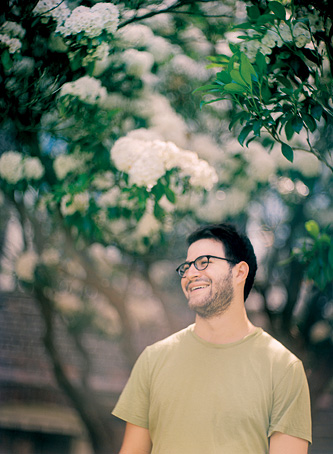
When Zohar Atkins decided to read the classics in their original Greek, he signed up for a summer course at the City University of New York. "It packed five semesters of language into a few weeks," Atkins says. When he returned to Brown in the fall, he enrolled in an advanced classics seminar. "I was able to read Plato's Phaedrus all in Greek," he says. "It was a fabulous experience."
Atkins hopes to one day become a scholar and a rabbi, and next year he'll begin at Oxford University on a Rhodes Scholarship. Though it's typical for Rhodes scholars to earn a master's at Oxford, Zohar plans to earn a PhD in theology, concentrating on the German philosopher Martin Heidegger and the Jewish theologian Franz Rosenzweig.
During his first semester at Brown, Atkins, who grew up in Montclair, New Jersey, took a course called Good and Evil. "It laid the ground for my intellectual agenda for the next four years," Atkins says. He says the course triggered his fascination with the big questions: "What is good? What is evil? Why do bad things happen to good people? Is evil radical or banal?" Four years later, he can say, "The appeal is in realizing the answers to these questions might be murky and the asking of the questions might be the closest we can come to answering any of them." Understanding this limitation, he says, "might teach that compassion and humility are better than having the answers themselves."
Atkins also volunteered at the Rhode Island Adult Correctional Institute in Cranston, teaching poetry to male prisoners. For a course he designed on mythology, he asked inmates to read the Bible, Ovid, and the Argentinean writer Jorge Luis Borges. He also asked them to write their own myths. He says he tried to instill "a belief in the power of language" and to create a "space for the prisoners to have creative expression." He also saw what he was doing as a form of moral instruction.
"One of the things that poetry does on an ethical level," Atkins says, "is that it doesn't just let you say what you want to say, but it forces you to say it to another. To consider how your poetry will affect another is the beginning of an ethical consciousness."
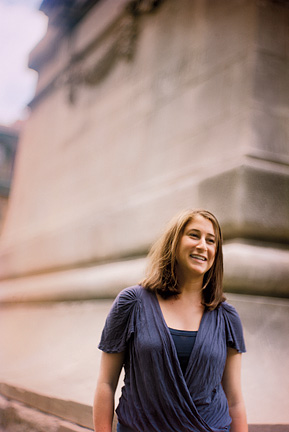
For a long time now, Americans have been able to go to a charity's web site, peruse listings from all over the developing world, and pick out an individual or family they want to support financially. Kate Kolbert-Hyle and several of her classmates decided Americans should be able to help Americans in the same way. So they created CO-Fund, a nonprofit organization that pairs small and large philanthropists with Rhode Island students who can't afford college.
Kolbert-Hyle and her partners in the project, Cody Simmons '10 and Kayle Gishen '12, began working on CO-Fund last September. "This year has been a lot of CO-Fund, but in a good way," says Kolbert-Hyle, who grew up in Philadelphia and majored in public policy. She says the experience has taught her about the intricacies of building a charitable organization that would persist even after she graduated.
Perhaps the most difficult task was choosing which individuals to list on the website. Dozens of students applied from across the state, most of them needy and deserving. But Kolbert-Hyle and the others decided that, for their pilot program, they would choose only four. "It was an excruciating decision," Kolbert-Hyle says.
The three seniors interviewed applicants and asked them to write essays and send letters of reference. They also imposed some restrictions on the recipients of the money. The students, for example, should already have qualified for financial aid from their colleges, and the aid had to be insufficient to cover their bills. Recipients also had to sign a contract pledging to repay in kind the money they had received. Among their options were to complete 100 hours of community service, to work for CO-Fund or a partner organization for a year, or to donate one-fifth of the money they received to another CO-Fund student after graduating and working for five years.
In the end, CO-Fund's leaders chose four low-income students to put up on the site when it went live in May. They include James from Shea High School in Pawtucket, Rhode Island, who is bound for Pace University in New York, and Makayla, a freshman at the University of Rhode Island, whose financial aid package is $7,000 short of what she needs to live on. (For privacy reasons, the students' last names aren't given). In her profile on the site, Makayla writes, "I'm determined to graduate from college because I want to make my parents proud. Even though they passed away, it was their goal for me to go to college and live a better life than they did." Within just a few days, all four of the candidates had received anywhere from 14 to 20 percent of the total money they need.
Next year, Kolbert-Hyle is bound for Mountain View, California, where she will likely work in Google's marketing department. Naturally, she's worried about balancing the responsibilities of her new job with her work for CO-Fund, which is why the group is now looking to hire an executive director. CO-Fund was the "perfect capstone to my interests" in public policy and entrepreneurship, Kolbert-Hyle says. "It's been a total learning experience for me, which I loved."
Portraits by Erik Gould.




